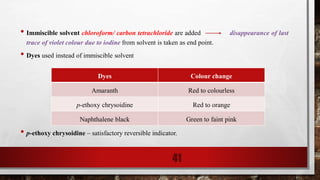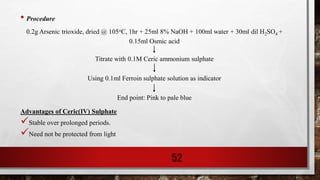The document provides an overview of oxidation-reduction (redox) reactions and titrations, detailing the principles, types of redox titrations, and relevant indicators. It explains oxidation as the loss of electrons and reduction as the gain of electrons in reactions, along with examples of common redox titrations such as permanganometry, iodimetry, and iodometry. The document also includes methods for preparing solutions and detecting endpoints during these titrations.
















![• KMnO4 act as a self indicator, hence the reaction does not require the addition of any other indicator to
detect the end point.
• KMnO4 act as an oxidising agent not only in acidic solutions but also in alkaline and neutral media. It
exhibits different oxidation states in different media.
1. Acidic media
KMnO4 itself act as an indicator.
MnO4
- is reduced to Mn2+
MnO4
-
8H+
5e-
Mn2+ 4H2O
+ + +
Reduction
2KMnO4 3H2SO4
K2SO4
2MnSO4
3H2O 5[O]
+ + + +
17](https://image.slidesharecdn.com/4-240120050224-5171202f/85/REDOX-TITRATION-pdf-17-320.jpg)




















![PRINCIPLE
1. Reaction between KIO3 and reducing agents in moderately acidic solution stop at state iodate
reduced to iodine.
2. Reaction with more powerful reductant like Titanium chloride Iodate reduced to
Iodide.
3. In more strongly acid solution reduction to Iodine monochioride. [more widely used]
KIO3 – act as more powerful oxidizing agents.
KIO3 5KI 6HCl 3I2 6KCl 3H2O
2KIO3
5H3AsO3 2HCl I2 5H3AsO4 H2O 2KCl
+ + + +
+ + + + +
IO3
-
6Ti3+
6H+
I-
6Ti4+
3H2O
+ + + +
IO3
-
6H+
Cl-
4e ICl 3H2O
+ + + +
38](https://image.slidesharecdn.com/4-240120050224-5171202f/85/REDOX-TITRATION-pdf-38-320.jpg)





![PRINCIPLE
• Potassium dichromate is high purity and high stable compound.
• Aqueous solution not attacked by oxidisable impurities composition does not change on
keeping because of this property its an alternative for potassium permanganate.
• Aqueous solution stable towards light.
• Excellent primary standard.
• Titration only take place in acidic solution.
• In neutral solution Potassium dichromate turns out to be a mixture of dichromate and chromate
ion – Hydrolysis of dichromate ions to orange yellow chromate ions [weak oxidising agents].
Cr2O7
2-
14H+
6e-
2Cr3+
7H2O
Cr2O7
2-
6Fe2+
14H+
2Cr3+
6Fe3+
7H2O
+ + +
+ + + +
44](https://image.slidesharecdn.com/4-240120050224-5171202f/85/REDOX-TITRATION-pdf-44-320.jpg)






![Standardization of 0.1N Ceric Ammonium Sulphate
1. Using Arsenic Trioxide (As2O3)
• Reaction between Ceric(IV) Sulphate and As2O3 is very slow @ ordinary temperature Add
Osmium tetroxide soln which catalyst to increase the reaction rate.
• Oxidation of Sodium arsenite [As2O3 + NaOH] arsenate by ceric compound.
• Ferroin used as indicator give end point as colour change from pink to pale blue.
As2O3 6NaOH 2Na3AsO3 3H2O
+ +
Ce(SO4)2 Na3AsO3 H2O 2Ce2(SO4)3 Na3AsO4 H2SO4
4[Ce4+
e Ce3+
]
4Ce4+
Na3AsO3
+ + + +
+
=
51](https://image.slidesharecdn.com/4-240120050224-5171202f/85/REDOX-TITRATION-pdf-51-320.jpg)
























